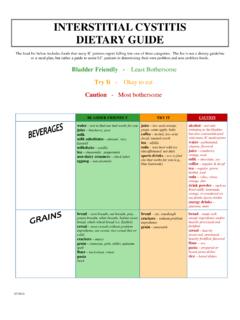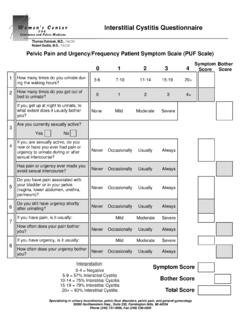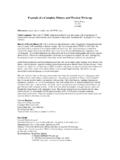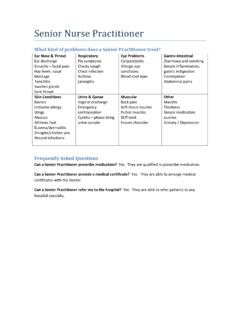Transcription of For oral use in dogs only Dogs that withdrew from the ...
1 For oral use in dogs onlyCaution: Federal (USA) Law restricts this drug to use by or on the order of a licensed : APOQUEL (oclacitinib maleate) is a synthetic Janus Kinase (JAK) inhibitor. The chemical composition of APOQUEL is N-methyl[trans-4-(methyl-7H-pyrrolo[2,3- d]pyrimidin-4-ylamino)cyclohexyl]methane sulfonamide (2Z)-2-butenedioate. The chemical structure of oclacitinib maleate is:Indications: Control of pruritus associated with allergic dermatitis and control of atopic dermatitis in dogs at least 12 months of and Administration: The dose of APOQUEL (oclacitinib maleate) tablets is to mg oclacitinib/lb ( to mg oclacitinib/kg) body weight, administered orally, twice daily for up to 14 days, and then administered once daily for maintenance therapy.
2 APOQUEL may be administered with or without food. Dosing ChartWeight Range (in lb)Weight Range (in Kg)Number of Tablets to be Administered mg mg Tablets16 mg : APOQUEL is not for use in dogs less than 12 months of age (see Animal Safety).APOQUEL is not for use in dogs with serious may increase susceptibility to infection, including demodicosis, and exacerbate neoplastic conditions (see Adverse Reactions and Animal Safety).Human Warnings: This product is not for human use. Keep this and all drugs out of reach of children. For use in dogs only. Wash hands immediately after handling the tablets.
3 In case of accidental eye contact, flush immediately with water or saline for at least 15 minutes and then seek medical attention. In case of accidental ingestion, seek medical attention :APOQUEL is not for use in breeding dogs, or pregnant or lactating use of APOQUEL has not been evaluated in combination with glucocorticoids, cyclosporine, or other systemic immunosuppressive receiving APOQUEL should be monitored for the development of infections, including demodicosis, and Reactions:Control of Atopic DermatitisIn a masked field study to assess the effectiveness and safety of oclacitinib for the control of atopic dermatitis in dogs, 152 dogs treated with APOQUEL and 147 dogs treated with placebo (vehicle control) were evaluated for safety.
4 The majority of dogs in the placebo group withdrew from the 112-day study by Day 16. Adverse reactions reported (and percent of dogs affected) during Days 0-16 included diarrhea ( APOQUEL, placebo), vomiting ( APOQUEL, placebo), anorexia ( APOQUEL, 0% placebo), new cutaneous or subcutaneous lump ( APOQUEL, placebo), and lethargy ( APOQUEL, placebo). In most cases, diarrhea, vomiting, anorexia, and lethargy spontaneously resolved with continued dosing. Dogs on APOQUEL had decreased leukocytes (neutrophil, eosinophil, and monocyte counts) and serum globulin, and increased cholesterol and lipase compared to the placebo group but group means remained within the normal range.
5 Mean lymphocyte counts were transiently increased at Day 14 in the APOQUEL that withdrew from the masked field study could enter an unmasked study where all dogs received APOQUEL. Between the masked and unmasked study, 283 dogs received at least one dose of APOQUEL. Of these 283 dogs, two dogs were withdrawn from study due to suspected treatment-related adverse reactions: one dog that had an intense flare-up of dermatitis and severe secondary pyoderma after 19 days of APOQUEL administration, and one dog that developed generalized demodicosis after 28 days of APOQUEL administration.
6 Two other dogs on APOQUEL were withdrawn from study due to suspected or confirmed malignant neoplasia and subsequently euthanized, including one dog that developed signs associated with a heart base mass after 21 days of APOQUEL administration, and one dog that developed a Grade III mast cell tumor after 60 days of APOQUEL administration. One of the 147 dogs in the placebo group developed a Grade I mast cell tumor and was withdrawn from the masked study. Additional dogs receiving APOQUEL were hospitalized for diagnosis and treatment of pneumonia (one dog), transient bloody vomiting and stool (one dog), and cystitis with urolithiasis (one dog).
7 In the 283 dogs that received APOQUEL, the following additional clinical signs were reported after beginning APOQUEL (percentage of dogs with at least one report of the clinical sign as a non-pre-existing finding): pyoderma ( ), non-specified dermal lumps ( ), otitis ( ), vomiting ( ), diarrhea ( ), histiocytoma ( ), cystitis ( ), anorexia ( ), lethargy ( ), yeast skin infections ( ), pododermatitis ( ), lipoma ( ), polydipsia ( ), lymphadenopathy ( ), nausea ( ), increased appetite ( ), aggression ( ), and weight loss ( ). Control of Pruritus Associated with Allergic DermatitisIn a masked field study to assess the effectiveness and safety of oclacitinib for the control of pruritus associated with allergic dermatitis in dogs, 216 dogs treated with APOQUEL and 220 dogs treated with placebo (vehicle control) were evaluated for safety.
8 During the 30-day study, there were no fatalities and no adverse reactions requiring hospital care. Adverse reactions reported (and percent of dogs affected) during Days 0-7 included diarrhea ( APOQUEL, placebo), vomiting ( APOQUEL, placebo), lethargy ( APOQUEL, placebo), anorexia ( APOQUEL, 0% placebo), and polydipsia ( APOQUEL, 0% placebo). In most of these cases, signs spontaneously resolved with continued dosing. Five APOQUEL group dogs were withdrawn from study because of: darkening areas of skin and fur (1 dog); diarrhea (1 dog); fever, lethargy and cystitis (1 dog); an inflamed footpad and vomiting (1 dog); and diarrhea, vomiting, and lethargy (1 dog).
9 Dogs in the APOQUEL group had a slight decrease in mean white blood cell counts (neutrophil, eosinophil, and monocyte counts) that remained within the normal reference range. Mean lymphocyte count for dogs in the APOQUEL group increased at Day 7, but returned to pretreatment levels by study end without a break in APOQUEL administration. Serum cholesterol increased in 25% of APOQUEL group dogs, but mean cholesterol remained within the reference Field StudyAfter completing APOQUEL field studies, 239 dogs enrolled in an unmasked (no placebo control), continuation therapy study receiving APOQUEL for an unrestricted period of time.
10 Mean time on this study was 372 days (range 1 to 610 days). Of these 239 dogs, one dog developed demodicosis following 273 days of APOQUEL administration. One dog developed dermal pigmented viral plaques following 266 days of APOQUEL administration. One dog developed a moderately severe bronchopneumonia after 272 days of APOQUEL administration; this infection resolved with antimicrobial treatment and temporary discontinuation of APOQUEL. One dog was euthanized after developing abdominal ascites and pleural effusion of unknown etiology after 450 days of APOQUEL administration.








